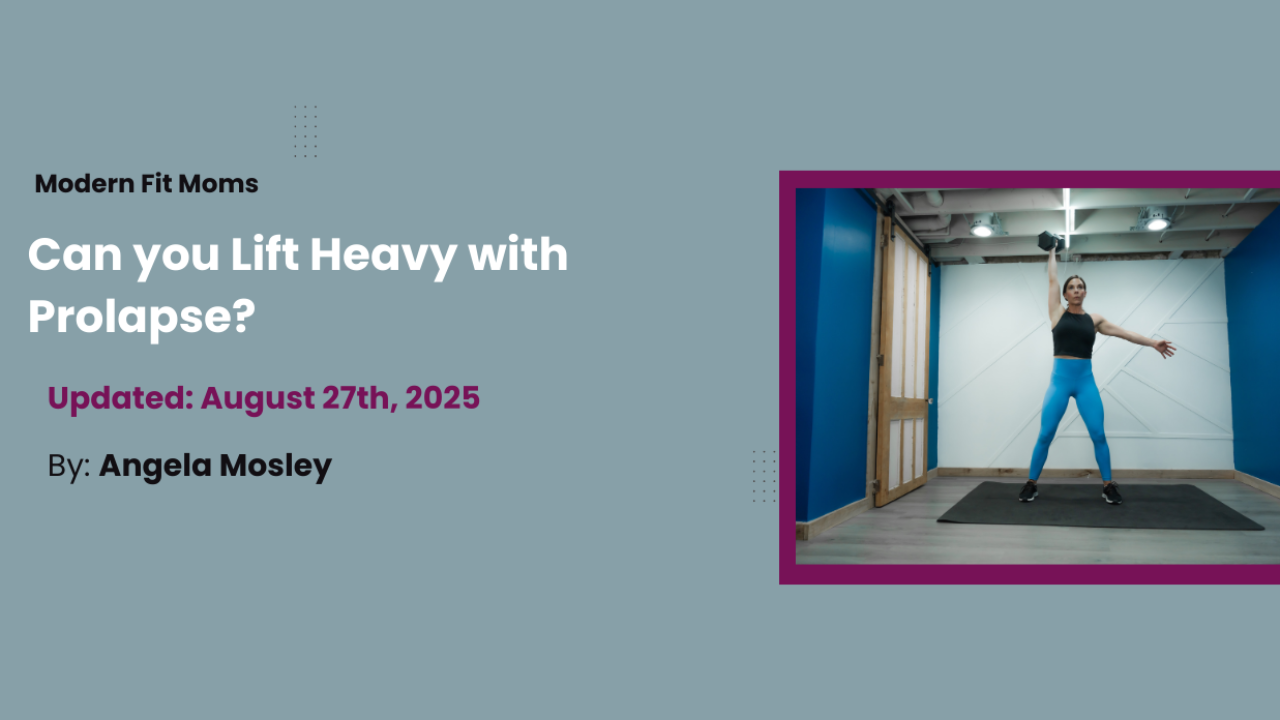
Can You Lift Heavy with Prolapse? Here's What You Need to Know
Oct 09, 2025If you’ve ever wondered whether it’s safe to lift weights with prolapse, you’re not alone. As a mom of four and someone who was diagnosed with stage 2 prolapse, I get asked this question all the time:
“Should I lift weights with prolapse, or will it make things worse?”
Short answer: YES — you can lift heavy with prolapse.
But here’s the truth: it’s not just about how heavy the weight is. It’s about how well your body manages intra-abdominal pressure.
When you understand how to breathe, align your body, and gradually build strength, lifting weights can actually help reduce prolapse symptoms and make you feel stronger in everyday life.
Check out my video that goes in-depth on how to safely (and effectively) lift weights with prolapse.
Why Strength Training Matters for Women with Prolapse
Every mom lifts heavy things daily — kids, car seats, groceries, laundry baskets. That means you’re already lifting weights, even outside the gym. The problem is that most of us don’t train for it.
When you train your body intentionally through strength training:
- Your glutes and core get stronger, helping support your pelvic floor.
- Your whole body shares the load, instead of your pelvic floor doing all the work.
- You feel more confident and capable — whether it’s carrying your toddler or moving furniture.
For me, lifting weights wasn’t just safe with prolapse — it was a major part of my recovery. My prolapse symptoms actually improved when I focused on glute strength, proper breathing, and alignment.
Breathing: How to Manage Pressure
Your pelvic floor naturally responds to your breath.
-
On the inhale, the pelvic floor lengthens.
-
On the exhale, the pelvic floor lifts.
For most women, exhaling on exertion (the hardest part of the lift) provides the best support. Others with a lot of tension may benefit from a reverse breathing strategy.
👉 Try both, and notice how your body and pelvic floor feel.
Pro tip: If you feel bulging, leaking, or straining — that’s a sign your pressure strategy needs adjusting, not that you should stop lifting altogether.
Posture & Alignment
Think “ribs stacked over pelvis.”
When your ribs flare out or your pelvis tips forward, it disrupts your pressure system and places extra strain on your pelvic floor.
✔️ Record yourself lifting to check your form.
✔️ Look for stacked ribs, neutral pelvis, and knees that track (not cave in).
This “stacked” position allows pressure to move smoothly through your core instead of pressing down on your pelvic floor.
How Heavy Should You Lift with Prolapse?
The answer is different for everyone. Start by asking:
What’s the heaviest thing I’m already lifting in daily life?
Use that as your baseline. Then build gradually.
-
Upper body: Chest and back muscles can often handle heavier weights. Shoulders and arms may need lighter loads.
-
Lower body: Your legs and glutes are strong — don’t be afraid to challenge them with heavier weights, especially in supported single-leg movements.
Remember, strength is built over time. Focus on progress, not perfection.
Should You Engage Your Pelvic Floor with Every Rep?
It depends. If you’re newly postpartum or your pelvic floor feels weak, gently cueing a lift (like a light Kegel) during squats may help you reconnect.
But long-term, your pelvic floor should respond naturally without you having to think about it. The stronger your whole body gets, the better your pelvic floor will respond to lifting.
My Story: From Surgery Consult to Stronger Than Ever
When I was first diagnosed, I was told I might need surgery. But through intentional strength training, pressure management, and restoring my glute + core strength, my prolapse improved so much that surgery was no longer recommended.
That’s why I believe lifting is not only safe for women with prolapse — it’s necessary.
The stronger you get, the easier it is to manage pressure and protect your pelvic floor.
Are You Ready to Get the Help You Deserve?
Here are some great resources!
FREE Pelvic Floor Blueprint: 4 steps to STOP Bladder Leaks & REDUCE Prolapse symptoms

✔️ Learn my 4 STEP METHOD to restore function at home without a bunch of kegels
✔️Self assessment to identify barriers in your body holding you back.
✔️Understand what exercises your body needs to break through barriers
✔️ 5 minute daily practices - Full follow along workouts for strengthening and relaxing the pelvic floor
👉 Grab the FREE Pelvic Floor Blueprint
CoreREVIVE:To increase your PELVIC FLOOR STRENGTH in 4 weeks or less so you can reduce leaks, improve prolapse & strengthen your core with just 25 minutes a day - WITHOUT doing a bunch of kegels.

LIFETIME ACCESS INCLUDED
- Pre-Recorded Educational Videos – Understand the pelvic floor, core, posture, glutes & diagram and how it all impacts prolapse and leaking
- Pre-recored tutorials & guide book to track your results & assessments to better understand what your body needs and what you need to work on to break through barriers holding you back.
- 4 Weeks of Pelvic Floor & Core Strengthening Workouts– Proven workouts designed to restore your pelvic floor, core and glutes effectively.
- Full 25-Minute Follow-Along Workouts – No guesswork, no complicated routines—just hit play and go! Perfect for busy moms.
👉 4-Week Pelvic Floor Foundations Program

✔️ Strengthen your pelvic floor at home with simple dumbbell workouts without endless kegels.
✔️Safely strength train without discomfort or leaks while being challenged
✔️ Discover ways to reduce symptoms of heaviness, pressure and leaks